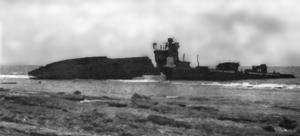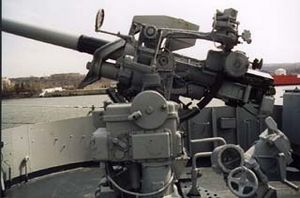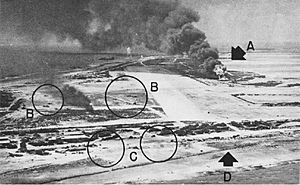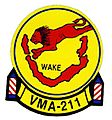Battle of Wake Island facts for kids
Quick facts for kids Battle of Wake Island |
|||||||
|---|---|---|---|---|---|---|---|
| Part of the Pacific Theater of World War II | |||||||
 A destroyed Japanese patrol boat (#33) on Wake. |
|||||||
|
|||||||
| Belligerents | |||||||
| Commanders and leaders | |||||||
| Strength | |||||||
| First Attempt (December 11): 3 light cruisers 6 destroyers 2 patrol boats 2 troop transports Reinforcements arriving for Second Attempt (December 23): 2 aircraft carriers 2 heavy cruisers 2 destroyers 2,500 infantry |
449 USMC personnel consisting of: 399 infantry of the 1st Marine Defense Battalion 55 det. VMF-211, 68 US Navy 5 U.S. Army personnel, Others |
||||||
| Casualties and losses | |||||||
| 820 killed, 333 wounded, 1 light cruiser heavily damaged, 2 destroyers sunk, 2 transports sunk, 1 submarine sunk, 7–8 aircraft shot down, 20 aircraft damaged. See [1] Note USMC History estimates 21 aircraft shot down and 51 aircraft damaged by flak. |
120 killed, 49 wounded, 2 MIA 12 aircraft 433 Military and 1,104 Civilian POWS of whom 5 military (killed Jan 1942) and 98 Civilian POWS (killed Oct 1943) were killed in captivity. In addition, 15 military and 82 civilians died as POWS |
||||||
The Battle of Wake Island was an important fight during World War II. It started on December 8, 1941. This was at the same time as the Attack on Pearl Harbor. The battle ended on December 23, 1941. American forces on Wake Island had to surrender to the Empire of Japan.
The fighting happened on and around the small island group of Wake Island. Both the Japanese and American forces used their air, land, and naval power. Marines from both sides played a big part in the battle.
After the battle, the Japanese held Wake Island for the rest of the Pacific War. Japanese troops on the island finally surrendered to United States Marines on September 4, 1945.
Contents
Preparing for Battle: Wake Island 1941
In January 1941, the United States Navy started building a military base on Wake Island. On August 19, the first troops arrived. They were from the 1st Marine Defense Battalion. There were about 450 officers and men. Major James P.S. Devereux led them. Also on the island were 68 U.S. Navy staff. About 1,221 civilian workers were there too.
The Marines had six large 5-inch (127mm) guns. These guns came from the battleship USS Texas. They also had twelve 3-inch (76mm) anti-aircraft guns. For closer combat, they had eighteen .50-caliber heavy machine guns and thirty M1917 Browning machine guns.
On December 8, just hours after the attack on Pearl Harbor, Japanese bombers attacked Wake Island. These were Mitsubishi G3M3 planes. They destroyed 8 of the 12 F4F-3 Wildcat fighter planes. These planes belonged to Marine Corps fighter squadron VMF-211.
First Japanese Attack on Wake Island
Early on the morning of December 11, the American forces fought back. The four remaining Wildcat planes helped stop the first Japanese landing attempt.
The U.S. Marines used their six 5-inch coastal artillery guns to fire at the Japanese ships. They managed to sink the Japanese destroyer Hayate. The Japanese ship Yubari was hit 11 times. The four Wildcat planes also sunk another destroyer, Kisaragi, by dropping a bomb on its back end.
The Japanese force had to pull back before they could land any troops. This was the first time the Japanese were defeated in the war.
Japanese air attacks on Wake Island continued. The Americans did not get any new supplies. The Japanese Navy then sent two aircraft carriers, Sōryū and Hiryū. These carriers were sent to help with the second landing attempt.
The U.S. Navy tried to send help to Wake Island. Admiral Frank Fletcher's Task Force 11 (TF 11) led this effort. Admiral Wilson Brown’s TF 14 also supported them. The carrier Saratoga was part of this group. Other ships included the oiler Neches and the seaplane tender Tangier. Three heavy cruisers and 10 destroyers also joined.
This group of ships carried the 4th Marine Defense Battalion. They also had the VMF-221 fighter squadron. This squadron had Brewster F2A-3 Buffalo fighter planes. They brought a lot of ammunition for guns and mortars.
Another group, TF 14, was sent to attack the Marshall Islands. This group included the carrier Lexington. The goal was to make the Japanese focus on the Marshall Islands instead of Wake Island.
However, on December 22, the U.S. Navy learned that two Japanese aircraft carriers were close to Wake Island. Because of this, TF 11 was ordered to return to Pearl Harbor. The U.S. leaders were worried about losing more ships.
Second Japanese Attack and Surrender

The second Japanese invasion force arrived on December 23. It included most of the same ships from the first attempt. The carriers Hiryu and Soryu were also there. About 1,500 Japanese marines were ready to land. The landings started early in the morning after a bombing attack.
After a full night and morning of fighting, the American troops on Wake Island had to surrender to the Japanese.
The U.S. Marines lost 47 men during the 15-day battle. Japanese losses were higher. Between 700 and 900 Japanese soldiers were killed. At least 300 more were wounded. Two Japanese destroyers were lost in the first attack. Also, 28 Japanese aircraft were shot down or damaged.
Japanese Control of Wake Island
The Japanese built strong defenses on Wake Island. American prisoners of war were forced to build bunkers and other defenses. The Japanese also brought in a large 8-inch (200 mm) naval gun.
The U.S. Navy used submarines to stop Japanese ships from reaching Wake Island. This caused the Japanese troops on the island to run out of food. On February 24, 1942, planes from the carrier Enterprise attacked the Japanese troops on Wake Island.
U.S. forces continued to bomb the island from 1942 until Japan surrendered in 1945. For example, on July 24, 1943, B-24 Liberator planes bombed Wake Island.
Images for kids
See also
 In Spanish: Batalla de la isla de Wake para niños
In Spanish: Batalla de la isla de Wake para niños







